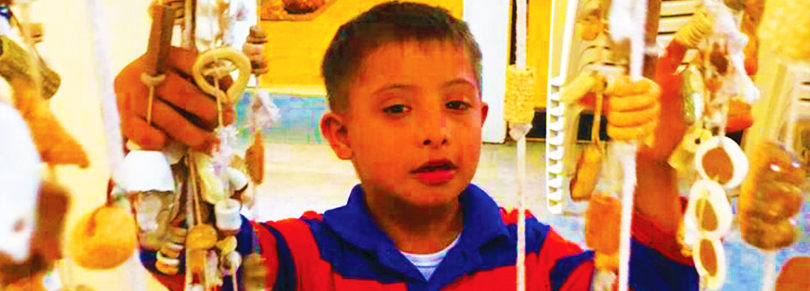I have always considered myself well educated, amongst the top percentile in the country. Educated in one of the most prestigious schools in Pune, went abroad for further studies, travelled and led a very fortunate life. But I had no idea what the term ‘special needs’ or ‘Down Syndrome’ actually meant and neither did those around me. This was and still is the level of awareness in our society!
This can’t be happening to me!
It was like a tsunami had hit us when we found out what it really meant. You never really think that something like this can happen to ‘you’ right? We read shocking stories, learn about your aunt’s friend’s sister who went through such unfortunate things, but when it happens to you, your whole world comes crashing down. When Advait came into our lives, he was just like any other baby, the most beautiful and perfect thing anyone could ask for, except that he had been labeled as the child who would not be able to lead a normal life, may not go to school, etc.
I read every word that I could find on ‘special needs’
All of us who go through difficult situations find a coping mechanism to help us get through the challenge we are faced with. Within a few days of finding out, my husband and I just dived into extensive research on Down syndrome, early intervention, therapy, diet, exercises and connecting with ‘special needs parents’ worldwide. This became my coping mechanism. I read every word that I could find on ‘special needs’ and ‘Down syndrome’.
I educated myself on every therapy available and immersed myself into understanding how the brain functions. I researched at night and implemented by day. I was Advait’s full time mother and therapist. I was obsessed. I had charts put up in the house with activities that needed to be done with him through the day. I taught my house help to implement them along with me and I had tremendous support from my friends and family.
When I look back to those times today I can still feel the excitement I experienced when I saw my child responding to all the stimulation he was getting. I witnessed his brain absorbing, learning and reconstructing. I saw him do all those things that doctors had stated ‘would not be possible’. Advait was becoming my inspiration and my teacher. He was meeting all his milestones, some on time and some slower but he was meeting them all at his pace.
MY best for HIS fullest potential
I wasn’t trying to make him Einstein or push him to achieve at the same level as my neighbor’s child. My clear focus was that I should do MY best so that he can achieve HIS fullest potential. I told myself that when I looked back I should never feel that I had not tried this therapy or that exercise. I wanted to know that I have given it my 100%. That’s it. Once I knew I had given my 100% I was comfortable with Advait’s development. This wasn’t a passive acceptance; in fact it is quite the opposite.
If I was trying to teach Advait a concept, let’s say of ‘solid, liquid and gas’, I would innovate and think of every possible way to teach him in a way that his brain would respond to it. My creativity was at its peak. With typical kids, you generally expose them to things once or twice and they get it. With special kids it involves intensity (excitement and creativity), frequency (repetition) and duration (over a period of time). And as a parent you have to have passion, commitment and creativity.
But why did God do this to me?
At one level there was this insane drive to do my best for my son. At another level I was coping with ‘Why me?’ This question haunted me for about 1.5 years. I looked around at all my friend’s kids and wondered how come they were all ‘ok’ and my child was ‘not ok’. Why did God to this to me? I struggled with this. But I now know this was my period of healing and the support I got from my family and my faith helped me get through this.
One of the things I found the toughest in the first 2 years was going for birthday parties, play dates, mother-toddler groups etc. I saw so many kids around me and ‘Why me?’ would keep ringing in my ears. This was the time when I was still not comfortable to just say ‘Yes, my son has Down syndrome’.
There was this funny sort of invisible door between me and another mom.
I was not yet fully ‘okay’ with my situation and the other mom knew that something was different but did not know if and how to address the apparent difference. One of the biggest turning points for me in my ‘journey of acceptance’ was when I was able to talk about Advait and Down syndrome openly in a social setting.
Talk about the elephant in the room
I realized that almost every parent was compassionate and wanted to reach out but did not know how. So it was just easier if I broke the ice and talked about the elephant in the room. Even now when I talk to new ‘special needs parents’ my most precious advice to them is, ‘you reach out to your friends, the community and to your family. When you have the courage to be okay with who you are and show your vulnerability, you will see magic happen in your support system and friendships’.
After Advait was born someone told me, a situation like this can make one a better person or a bitter person. I chose the better person.
Advait taught me Acceptance and Gratitude.
These are big words but Advait taught them to me in the simplest everyday way.
He taught me to accept him the way he is, accept the pace he wanted to achieve things, accept that he was just Advait.
With every smallest milestone that Advait met every single day, whether it was crawling 2 meters, or taking 2 steps, or making a bubble, he taught me gratitude.
I felt such a rush of joy with every step that he took, for every word he spoke. I had a diary where I used to write and count how many words he could speak. Speech is a challenge for children with Down syndrome and so every word that he uttered was a pure delight.
I don’t consider my son or myself special. I do know that he is different… but aren’t we all?
Today, 8 years later, there is such a beautiful acceptance of what is. Advait is being taught by a friend of mine who homeschools him along with her kids. I consciously chose this for him after trying various other schools because I felt his personality best shone when he was in smaller groups and not because he has Down syndrome. He loves his school, he plays football and badminton, he loves cycling, puzzles, swimming and eating ice-cream. He is independent and has a wicked sense of humor, he is the most gentle and loving soul I have ever met. I am thankful everyday for everything that I have.
| Special Needs Language & Ettiquette |
|
As we’ve become more sensitive to the needs of persons with disabilities, one aspect of society that has remained stubbornly behind the curve are the words we use to describe another. Being referred to as a “special needs student” or “disabled child” is likely to make a young person feel he or she has challenges that cannot be overcome. It fosters a sense of hopelessness. It implies that a child is broken; that he or she is in need of repair and is lacking in some way. Instead, being referred to as a child with special needs or a child with a disability is referencing their condition and not labeling their esteem. Here are some helpful tips towards a more positive approach:
For more info visit http://www.cerebralpalsy.org/informati on/disability/etiquette |






Leave a Comment